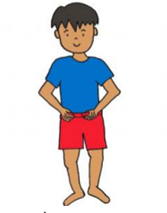Children can become involved in dressing from a very early stage. Developing body awareness, recognising different types of clothing and participating when others help them to get dressed, are all skills that build independence.
As children get older, some aspects of dressing can be very challenging; tying laces, doing buttons, getting clothes the right way round. This can be frustrating for your child, but support them to keep practicing.
Body Awareness
Play body awareness games to develop understanding of different body parts. This could be songs such as 'head, shoulders, knees and toes' or playing dress up with dolls or figures. Talk to your child about which bits of clothing go on each part of the body.
When playing or helping your child get dressed talk about what you are doing. Use simple language to make them such as ’hat on!’ or ’socks first’.
Keep Practicing!
Practice during times when you have plenty of time for your child to dress themselves. Try before bed or at weekends when you are not in such a rush.
Use reward charts and lots of specific praise - “I love how you put your trousers on with the button at the front!”. Hearing positive feedback with motivate your child to keep trying.
Try using picture checklists or visual schedules and help them by turning the clothing the right way round before asking them to dress.
Link dressing to their daily routine to build an understanding of why or when they may need to do it. For example, shoes and coat on just before leaving the house or pyjamas on for bedtime.
Simplify The Activity
Order of Dressing
All children need to learn what order to put their clothes on. They need to know that their pants go on before their trousers and their socks go on before their shoes.
children need to learn what order to put their clothes on. They need to know that their pants go on before their trousers and their socks go on before their shoes.
Involve your child in learning the order of the dressing as early as possible. Sing songs about dressing. Talk to your child about dressing. Play dressing up games. Practice dressing dolls or teddies.
Talk about the order of dressing when you or your child are dressing. Ask questions e.g. “What goes on next?”.
Lay clothes out in the order they should go on. This is usually easier if you lay them out in a line rather than putting them on top of each other.
Lots of practice! Give your child opportunities to practice every day. Try not to practice when you are in a hurry as this will cause stress for your both.
If your child makes a mistake help them to work out what went wrong and how to fix it. Don’t fix it for them.
If they forget to put their pants on first let them finish getting dressed so that they can find their pants at the end.
You can download some visual aids to support your child with the morning routine.
Backward Chaining
When teaching a new skill we often start at the beginning. This can be challenging for children sometimes as they get frustrated. You can give your child a sense of achievement by using the backward chaining technique. Backward chaining is particularly useful when learning self-care skills like dressing.
What is Backward Chaining?
You start by breaking the task down into small steps. You teach your child the last step first, working backwards from the goal.
You complete all the steps except the last one. You get your child to practice the final step. They will enjoy the success that comes from completing a task. Once your child can do the last step you complete all the steps except for the last two. You teach your child the second from last step and they then complete the last step themselves. Even more success! Keep going until you are teaching them they whole sequence.
Putting Clothes on The Right Way Round
Putting clothes on the right way round is tricky. Most children still put their clothes on back to front sometimes when they start school. Some children can find this challenging as they move through school. As with all dressing skills it is best to start teaching this skill as soon as you can.
Choose clothes that are easy to spot the front and the back. Logos or pictures can give extra clues to your child. You could put a sticker or mark with a pen if the clothing doesn't have a label on the back.
Lay the clothes out for your child and point out to them the front and back.
Talk about what clothes look like when they are the wrong way around or inside out. Can they see the label on the outside or are their pockets hidden inside by mistake?
Children's Occupational Therapists work with children from birth to 18 (or 19 if attending Complex Need schools). If your child or young person is under the Occupational Therapy teams, you can speak to them about any questions you may have.
If you think your child requires specialist support, please speak to their GP.
If you have any questions about your child or young person's general health or development, you can contact the Healthy Child Programme by calling Just One Number on 0300 300 0123 or texting Parentline on 07520 631590. Our opening hours are 8am-6pm Monday-Friday (excluding bank holidays) and 9am-1pm on Saturdays.